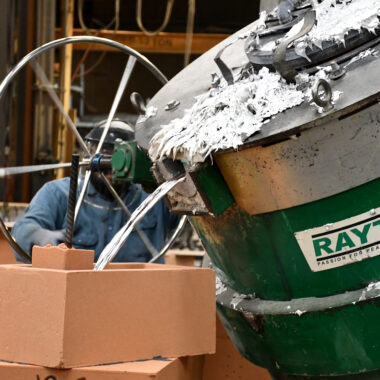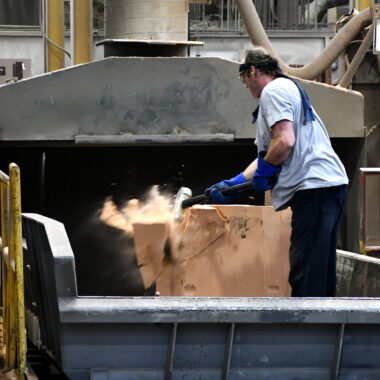Unraveling About Aluminum Casting: From Essentials to Knowledge
Unraveling About Aluminum Casting: From Essentials to Knowledge
Blog Article
Crafting Perfection: Just How to Attain High-Quality Light Weight Aluminum Castings Every Single Time
In the world of light weight aluminum casting, the search of excellence is a constant journey that calls for a thorough technique and a keen understanding of the intricacies entailed. Accomplishing consistent high-quality light weight aluminum castings requires a detailed grasp of the procedures, from choosing the appropriate alloy to implementing exact mold layouts and thoroughly managing spreading specifications. Nonetheless, real mastery lies in the ability to carry out these elements flawlessly to produce remarkable castings every single time. As we discover the complexities of crafting excellence in aluminum castings, revealing the essential methods and techniques that cause impeccable results comes to be paramount for those pursuing quality in this specialized field.
Recognizing Aluminum Spreading Processes
Aluminum casting processes, vital in the manufacturing market, involve the complex transformation of molten light weight aluminum into strong kinds via a collection of carefully regulated actions. Recognizing these procedures is paramount to achieving top quality aluminum spreadings continually - about aluminum casting. The key approaches made use of in light weight aluminum casting are die casting, sand spreading, and financial investment spreading

Each of these procedures has its benefits and is selected based on aspects like intricacy, volume, and preferred surface of the aluminum casting. about aluminum casting. Understanding the complexities of these techniques is important for makers intending to create top notch light weight aluminum castings regularly
Selecting the Right Light Weight Aluminum Alloy
Choosing the ideal aluminum alloy is an important decision in the manufacturing of high-quality aluminum spreadings. When selecting a light weight aluminum alloy for casting, it is vital to take into consideration the certain requirements of the application to make sure optimum performance.
One of the most typically utilized light weight aluminum alloys for spreading is A356 - about aluminum casting. For applications needing high toughness, 7075 light weight aluminum alloy is a preferred selection due to its phenomenal strength-to-weight proportion.
In enhancement to mechanical properties, considerations such as cost, availability, and post-casting processes should additionally affect the option of the appropriate light weight aluminum alloy. By very carefully examining these aspects, makers can make sure the production of top quality aluminum spreadings that fulfill the preferred specs.
Executing Proper Mold And Mildew Layout
Establishing Find Out More an efficient mold layout is vital for making sure the successful production of high-grade light weight aluminum castings. Proper mold and mildew style plays a significant function in attaining the desired qualities of the end product. To execute a successful mold layout, variables such as material circulation, cooling rates, and component geometry look at this web-site should be carefully taken into consideration.
One key facet of mold layout is making sure proper dental filling and solidification of the aluminum within the mold and mildew cavity. This entails developing jogger and gating systems that help with smooth steel flow and protect against problems such as air entrapment or insufficient filling. In addition, integrating air conditioning channels right into the mold and mildew style aids control solidification prices and reduce the danger of porosity you could try these out or contraction flaws.

Controlling Casting Parameters

Guaranteeing Post-Casting Top Quality Checks
To preserve the premium quality of light weight aluminum castings, detailed post-casting quality checks are crucial. After the casting procedure is finished, it is crucial to make sure that the end products meet the preferred criteria and specifications. Among the key quality checks entails examining the surface area finish of the castings to recognize any flaws such as porosity, cracks, or surface irregularities. This aesthetic examination is frequently supplemented by non-destructive testing techniques like ultrasonic screening or dye penetrant assessment to detect interior imperfections that may jeopardize the stability of the spreading.
Dimensional accuracy is one more critical element that has to be validated throughout post-casting quality checks. Dimensions of vital measurements and resistances should be required to validate that the castings satisfy the needed specs. In addition, mechanical residential or commercial properties such as firmness, tensile strength, and impact resistance may require to be reviewed via product screening to make sure that the spreadings possess the required strength and resilience for their intended application.
Conclusion
Finally, attaining high-grade light weight aluminum castings requires a complete understanding of the casting processes, picking the proper alloy, creating molds effectively, regulating casting parameters diligently, and carrying out post-casting high quality checks diligently. By adhering to these steps, manufacturers can continually create aluminum spreadings that satisfy the highest criteria of quality and efficiency.
Achieving regular top notch aluminum spreadings demands a thorough grasp of the processes, from choosing the appropriate alloy to implementing accurate mold and mildew styles and meticulously managing spreading specifications. The key techniques made use of in aluminum spreading are pass away casting, sand spreading, and investment casting.
Financial investment casting, likewise understood as precision spreading, includes producing wax patterns that are covered in ceramic to form mold and mildews.Selecting the suitable light weight aluminum alloy is a vital choice in the production of top notch light weight aluminum castings.Making sure precise control over casting criteria is essential for preserving uniformity and top quality in aluminum casting production.
Report this page